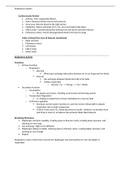Class notes
Respiratory System Overview and Cardiovascular System Recap
- Institution
- Durham College ( )
A recap of the cardiovascular system and a detailed information sheet on the respiratory system complete with terminology, mechanics, and diagrams.
[Show more]



